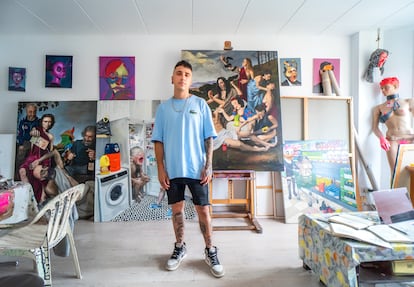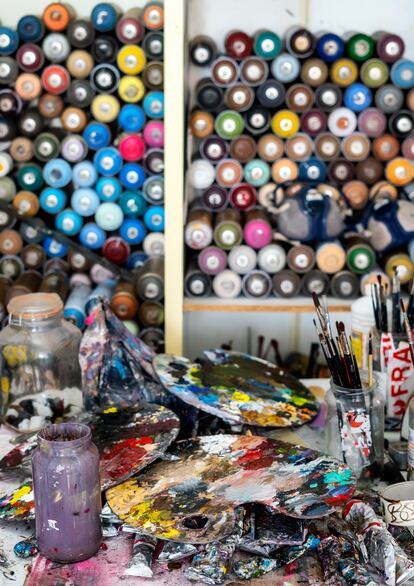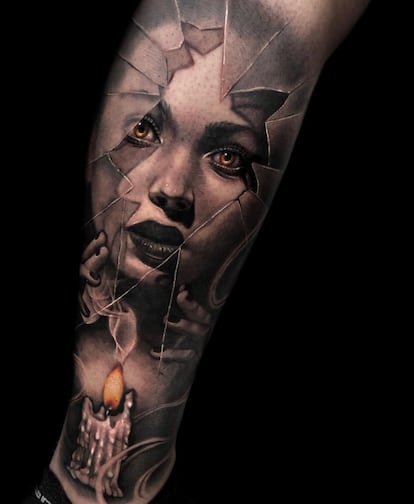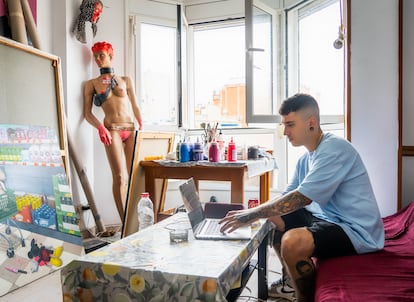Albert Bonet, the star tattoo artist of soccer players and an iconoclastic painter
He gained fame for tattooing famous soccer players, but his art goes far beyond that. He is an obsessive and committed creator with his own vision, falling somewhere between pessimistic and subversive

Albert Bonet is immersed in his paintings. He eats his breakfast, snacks and dinner and even sleeps surrounded by his own paintings, which fill the walls of the tiny studio and home he shares with a friend. He can barely move without running into his canvases, on which he works tirelessly, from sunrise to sunset, like a tireless art laborer who cannot afford to let his work lie fallow: “I am 27 years old, and I feel that I am at a decisive stage in my life, the moment when my dream of being a painter is coming true.”
After briefly going over his daily routine, Bonet concedes that he must impose a bit of discipline and separate his life from his creative space: “I’ll move into an apartment where I won’t take a single painting, and I’ll come to paint in the studio; I don’t know if [it will be] during office hours, but [it will have] some order and [allow] for the possibility of disconnecting, because dedicating yourself to something as intensely and compulsively as I have done in recent years with art can’t be a good thing.”

These days he is busy putting the finishing touches on a large-format painting. Like almost everything he paints, it is rotund, dark and macabre, full of dark humor. He tells us that the artwork is a contemporary reinterpretation of the myth of Orpheus. But it’s not the tale of Orpheus’s descent into hell and the definitive loss of his beloved, Eurydice, but of what follows: the execution of Orpheus at the hands of the Maenads, the followers of the god Dionysus. In Bonet’s version, the Maenads are a wild horde of riot grrrls, led by Disney’s Cinderella, who torture a poor traveling musician to death. The painting includes simultaneous nods to Caravaggio, the great tradition of baroque painting, the pop constellation and the starkest, trashiest urban art.

Bonet blends his fascination for the “classics” with subversion, street counterculture and social commentary. Among the works that surround him on a daily basis, the image of Mickey Mouse strangled, stabbed, dismembered or drowned in a latrine recurs. There is no doubt that Bonet has a score to settle with the “damned mouse.” It’s not just that Bonet’s entry into the adult world led him to rebel against childhood fantasies; there’s more to it than that. “Walt Disney was an ultra-conservative, racist, sexist and homophobic hypocrite,” he says, with his characteristic bluntness and rapid-fire speech. “He found a nice way to sell us his repugnant discourse, and today we find Mickey [everywhere]… as an icon of innocence and consumer culture.”
Bonet is from Riba-roja d’Ebre, Spain, a town of 1,112 inhabitants on the border of the province of Tarragona, near Lleida and Aragon. That’s where he grew up, became enthusiastic about drawing, handicrafts and paint stains at a very early age, and began to work as a tattoo artist. When he was 13 years old, his parents promised to buy him a kit to make tattoos if he managed to pass school that year; at the time, that goal seemed unlikely, because Bonet was going “downhill fast” and at risk of failing school. But he passed. His parents did not consider the fact that, as much as he hated his studies, he is persistent and tenacious; he accomplishes almost everything he sets out to do. Tattoo machine in hand, Bonet began to do tattoos for “the county’s nuttiest people, the drunks, bohemians and punks crazy enough to let a kid who was just starting out inject ink into their skin.”



Tattoos and graffiti were his best teachers. Bonet is somewhat embarrassed to describe himself as self-taught; instead, he says that he is the “student of multiple teachers.” He considers himself “a sponge”; he’s always curious, always restless, always active. As an art student at a high school in Lleida, he had an epiphany when he visited the Prado Museum with his class: “A teacher who knows me well told me to forget about the group and walk through the rooms at my own pace. And that’s what I did. I wandered around aimlessly, soaking in the paintings.”
When he arrived in Barcelona to study at a school for comics, he went through a period in which he felt he was a disciple of Antonio López, the quintessential Spanish hyperrealist. At that time, Bonet was obsessed with “developing an increasingly precise technique, making paintings with a level of detail and accuracy on par with photography.” But not anymore; he has moved past that stage: “I saw Dream of Light, and I thought [to myself] that Antonio López [was] light years away from my vision of things. He strikes me as a very talented man, but he makes empty paintings that don’t have any content.”
Bonet set out to paint pictures that tell stories, and the stories he comes up with are almost always gruesome and have something sordid about them. Sex and violence are often part of the equation. They also reflect his pronounced pessimism about the state of the world, the pettiness, selfishness and daily misery that he sees everywhere around him.

While he was trying to find his way in painting, Bonet started to make a living as a tattoo artist in a Barcelona studio, Blessed Art. He counted soccer players like Neymar Jr., Luis Suárez, Danilo and Arnau Tenas among his clients. Neymar’s “very simple, meritless tattoo” brought Bonet his first taste of fame. “It was all a bit crazy. He showed up surrounded by his entourage in a limousine with tinted windows. I am not starstruck at all, and I don’t have the slightest interest in soccer… At one point, I threatened to go home, because they were going at their own pace, without any respect for other people’s schedules. So, they apologized to me, and Neymar and some of his friends finally sat down to have me do his tattoo, which was a sort of shared memory of Barcelona, because Neymar had already decided to go to Paris Saint Germain. That was the day that [Spanish soccer player] Gerard Piqué posted his famous tweet — ‘He’s staying!’ — and everyone from sports media was trying to track down the Brazilian, who was with me, in the workshop.”
Bonet acknowledges that this old story is now water under the bridge: “I’ve already left the phase of doing tattoos for soccer players behind [me]. Undoubtedly, I will continue doing tattoos, but it will be more personal work, less routine. Right now, my priority is painting.” His Stakhanovism, dexterity and unique point of view have led him to sell work at a frenetic pace. He has participated in institutional projects, such as the creation of a mural dedicated to Saint Agda, the local patron saint, in his hometown of Riba-roja. He won a prize at the prestigious Tokyo Tower Art Fair. And he has remained true to himself, without subterfuge or concessions. He is happy with how life has treated him, though he still believes that “the world is rotten and full of shit everywhere.”
Sign up for our weekly newsletter to get more English-language news coverage from EL PAÍS USA Edition
Tu suscripción se está usando en otro dispositivo
¿Quieres añadir otro usuario a tu suscripción?
Si continúas leyendo en este dispositivo, no se podrá leer en el otro.
FlechaTu suscripción se está usando en otro dispositivo y solo puedes acceder a EL PAÍS desde un dispositivo a la vez.
Si quieres compartir tu cuenta, cambia tu suscripción a la modalidad Premium, así podrás añadir otro usuario. Cada uno accederá con su propia cuenta de email, lo que os permitirá personalizar vuestra experiencia en EL PAÍS.
¿Tienes una suscripción de empresa? Accede aquí para contratar más cuentas.
En el caso de no saber quién está usando tu cuenta, te recomendamos cambiar tu contraseña aquí.
Si decides continuar compartiendo tu cuenta, este mensaje se mostrará en tu dispositivo y en el de la otra persona que está usando tu cuenta de forma indefinida, afectando a tu experiencia de lectura. Puedes consultar aquí los términos y condiciones de la suscripción digital.
More information
Archived In
Últimas noticias
Most viewed
- Alain Aspect, Nobel laureate in physics: ‘Einstein was so smart that he would have had to recognize quantum entanglement’
- Maps of the US attack on Venezuela: Targets, airspace and deployed fleet
- Oil, gold and rare earth elements: the backdrop to US political tension with Venezuela
- Key points of the military attack on Venezuela: Early morning bombings and a ‘captured’ president
- The US bombing of Venezuela, in pictures











































